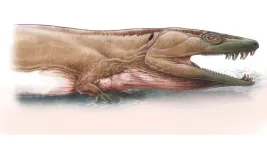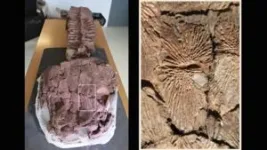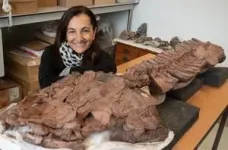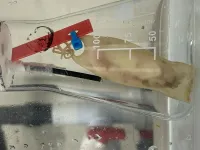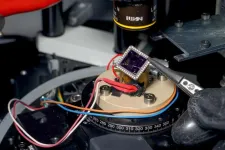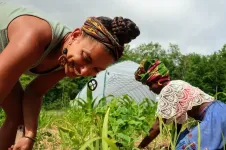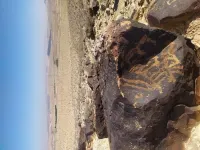(Press-News.org) After three years of meticulous study, an international team of researchers has announced the discovery of a fossilised giant basal tetrapod in Namibia's arid heartland in Nature. A basal tetrapod is an early four-legged vertebrate with fingers and toes, which lived during the transition from water to land. These ancient carnivores are among the earliest ancestors of all modern animals. This nearly complete 3-meter-long skeleton of an adult, unearthed in the Ugab River valley in Damaraland, is the largest ever discovered. This discovery is significant because it challenges previous assumptions that these early four-legged vertebrates, which lived during the transition from water to land around 280 million years ago, were only found in the northern hemisphere. The new species, named Gaiasia jennyae, provides crucial insights into the early evolution of land-dwelling animals and shows how important southern continents are in future research on this topic.
Funded by PAST Africa and the National Geographic Society, the team, comprising palaeontologists from South Africa, Namibia, Argentina, and the US, was searching for evidence of the earliest four-legged animals to set foot on land in this part of the ancient supercontinent Gondwana. Gondwana, which existed from about 550 to 180 million years ago, included what are now South America, Africa, Antarctica, Australia, and India.
The team was conducting fieldwork in Namibia, meticulously surveying the rugged terrain, when they spotted something exciting. “The nearly complete skeleton was preserved in mudstone from an ancient freshwater lake. As the soft tissue decomposed, gases formed that caused calcium carbonate to crystallise around the bones, creating a hard crust that protected them from being crushed as they were buried deeper,” explains Prof. Roger Smith, Distinguished Professor at the Evolutionary Studies Institute at Wits and Emeritus Research Associate at Iziko Museums, Cape Town.
Mr. Sibusiso Mtungata, a highly skilled fossil technician from the Iziko Museum, describes the discovery moment: “We had found isolated vertebrae of something big, so we were looking for a more complete skeleton. I came across two round cylinders of rock with bone in the middle which fitted together - and then a third. I called Roger over to help me find more, and as we walked upslope, he spotted a large flat rock which he recognised as the head. When we looked along the edge and saw rows of teeth, we knew we had finally found what we had been searching for - a nearly complete skull and skeleton!”
Prof. Claudia Marsicano from the University of Buenos Aires, Argentina, elaborates on the significance of the find. "As soon as I saw this enormous animal, I knew it was a different species. There is no record of giant basal tetrapods during the Carboniferous-Permian transition (approximately 299 million years ago) anywhere in the world, and certainly none from the southern continents that made up Gondwana. What caught my attention next was the structure of the front part of the skull, which was sticking out of the ground. It showed unusually interlocking large fangs." It was an ambush predator that ate the fish that lived in the same lake.
Collecting the fossil took some time. “The skeleton had already weathered out of the rock, so there was no need for excavation, but the whole team spent hours searching for fragments that had fallen off the skull block and moved downslope,” says Mr. Mtungata. The skeleton was then taken to the Iziko South African Museum in Cape Town to be painstakingly prepared in the Karoo Fossil Laboratory, a process that took two years. “Mechanical preparation was a challenge because it was too large to CT scan, so I didn’t know what to expect – especially in the palate where teeth of all different sizes were everywhere. And there was up to 10cm of rock around the vertebrae that needed to be drilled away, creating so much red dust that we had to bring in a special extractor,” says Mr. Mtungata.
The fossil preparation revealed that the large, flattened skull was decorated with unusual patterns and had a unique palate structure. It had enormous, backward-curved fangs in both the upper and lower jaws, making its mouth unlike anything seen before. Initially thought to be a large amphibian, further study showed that the skull had features of much older, less evolved four-legged animals, previously found only in older rocks in the northern hemisphere.
"We named the new species Gaiasia jennyae. 'Gaiasia' is after Gaias, a nearby desert spring where the fossil was found. 'Jennyae' honours Professor Jennifer Clack, a world-renowned expert in early tetrapod evolution, who passed away in 2020," explains Prof. Roger Smith.
The new findings strongly suggest that early tetrapods were well-established in the cold-temperate regions of Gondwana as early as the Carboniferous-Permian transition. “This discovery challenges previous beliefs about early tetrapod distribution and evolution, which were mostly based on fossils from the northern hemisphere,” says Prof. Marsicano. “Our research shows a well-established early Permian fauna, with Gaiasia as an apex predator, in rocks from high-latitude Gondwana, now located in central Namibia. This challenges previous ideas and proves that the early history of tetrapods in Pangea during the Palaeozoic was much more complex than we thought."
The specimen has been returned to Windhoek, where it will soon be on display in the Geological Museum of Namibia.
END
Gondwana’s ultimate hunter – New giant fossil tetrapod found in Namibia
2024-07-05
ELSE PRESS RELEASES FROM THIS DATE:
Offshore windfarms – A threat for electro-sensitive sharks?
2024-07-05
An ongoing research project into the impact of offshore windfarm electromagnetic fields on shark development reveals that the alternating electric currents produced by underwater windfarm cables seems not to disrupt the growth or survival of sharks.
Offshore windfarms are one of the most common marine renewable energy (MRE) producers, and are seen as a pivotal technology in the global transition towards renewable energy and away from fossil fuels that contribute to climate change.
However, their proliferation in marine environments raises new questions about their impacts on wildlife. Energy operators and ...
A 2D device for quantum cooling
2024-07-05
To perform quantum computations, quantum bits (qubits) must be cooled down to temperatures in the millikelvin range (close to -273 Celsius), to slow down atomic motion and minimize noise. However, the electronics used to manage these quantum circuits generate heat, which is difficult to remove at such low temperatures. Most current technologies must therefore separate quantum circuits from their electronic components, causing noise and inefficiencies that hinder the realization of larger quantum systems beyond the lab.
Researchers in EPFL’s Laboratory of ...
MIT engineers find a way to protect microbes from extreme conditions
2024-07-05
Microbes that are used for health, agricultural, or other applications need to be able to withstand extreme conditions, and ideally the manufacturing processes used to make tablets for long-term storage. MIT researchers have now developed a new way to make microbes hardy enough to withstand these extreme conditions.
Their method involves mixing bacteria with food and drug additives from a list of compounds that the FDA classifies as “generally regarded as safe.” The researchers identified formulations that help to stabilize several different types ...
Why the U.S. food system needs agroecology
2024-07-05
Agroecology—a science, practice, and movement which seeks social, political, economic, and environmental sustainability in the global food system—is gaining momentum in the U.S., according to a new Dartmouth-led commentary in Nature Food. As the co-authors report, the approach requires coordination between scientists, farmers, and activists.
"When it comes to sustainable food and agriculture, people in the U.S. tend to be more familiar with organic farming, the production of food without synthetic inputs, and regenerative agriculture, which primarily strives to restore soil health," says lead author Theresa Ong, an assistant professor of environmental studies ...
Fresh wind blows from historical supernova
2024-07-05
A mysterious remnant from a rare type of supernova recorded in 1181 has been explained for the first time. Two white dwarf stars collided, creating a temporary “guest star,” now labeled supernova (SN) 1181, which was recorded in historical documents in Japan and elsewhere in Asia. However, after the star dimmed, its location and structure remained a mystery until a team pinpointed its location in 2021. Now, through computer modeling and observational analysis, researchers have recreated the structure of the remnant white dwarf, a rare occurrence, explaining its ...
Desert-loving fungi and lichens pose deadly threat to 5,000-year-old rock art
2024-07-05
The Negev desert of southern Israel is renowned for its unique rock art. Since at least the third millennium BCE, the hunters, shepherds, and merchants who roamed the Negev have left thousands of carvings (‘petroglyphs’) on the rocks. These figures are mostly cut into ‘desert varnish’: a thin black coating on limestone rock, which forms naturally. Many represent animals such as ibexes, goats, horses, donkeys, and domestic camels, but abstract forms also occur.
Now, a study published in Frontiers in Fungal ...
Scientists map how deadly bacteria evolved to become epidemic
2024-07-04
Pseudomonas aeruginosa – an environmental bacteria that can cause devastating multidrug-resistant infections, particularly in people with underlying lung conditions – evolved rapidly and then spread globally over the last 200 years, probably driven by changes in human behaviour, a new study has found.
P. aeruginosa is responsible for over 500,000 deaths per year around the world, of which over 300,000 are associated with antimicrobial resistance (AMR). People with conditions such as COPD (smoking-related lung damage), cystic fibrosis (CF), and non-CF bronchiectasis, are particularly susceptible.
How P. aeruginosa evolved from an environmental organism into a ...
Biodegradable biomass-based aerogel for sustainable radiative cooling
2024-07-04
An aerogel made from gelatin and DNA surpasses 100% solar reflectance, yielding exceptional radiative cooling, a new study reports. It is also biodegradable. The novel approach paves the way for high-performance next-generation radiative cooling materials, promoting environmentally friendly advancements in the field. Sustainable, energy-efficient, and environmentally conscious cooling technologies are crucial for adapting to our rapidly warming world. Compared to traditional refrigeration systems, passive radiative cooling technologies consume less energy and emit fewer greenhouse gasses, making them ...
New brain-to-nerve signaling mechanism reveals potential path to migraine pain
2024-07-04
The rapid influx of cerebral spinal fluid (CSF) and protein solutes released during cortical spreading depression (CSD) in the brain activates neurons to trigger aural migraine headaches, according to a new mouse study. The findings identify a novel non-synaptic signaling mechanism between the brain and peripheral sensory system important for migraine. They also suggest potential pharmacological targets for treating the painful disorder. Migraine with aura, or an aural migraine, is a distinct headache disorder that can include sensory disturbances, such as hearing- or vision-related symptoms that precede onset of ...
Federal grid reforms alone are not enough to solve clean energy interconnection problem
2024-07-04
Although energy production from wind and solar has grown rapidly in the United States, its integration into the national electric grid has been impeded by poor grid interconnection policies, leaving thousands of new facilities for generating renewable energy waiting to be connected to the grid. In a Policy Forum, Les Armstrong and colleagues highlight the interconnection problem and discuss whether federal grid policy reforms alone are enough to address it. Armstrong et al. argue that while the US Federal Energy Regulatory Commission’s (FERC) recent orders to improve this bottleneck are a step in the right direction, fundamental issues remain unaddressed. In the ...
